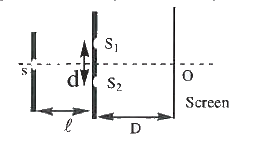In Young's double slit experimentt. When a glass plate (μ=1.5) of thickness is introduce path of one of the interfering beams (wavelength =λ) the intensity at the position where centre maxima occurred previous remains unchanged. The minimum thickness Solution in Telugu
2λ
λ
23λ
λ3
The correct Answer is:A
Step by step video, text & image solution for In Young's double slit experimentt. When a glass plate (mu = 1.5) of thickness is introduce path of one of the interfering beams (wavelength = lambda) the intensity at the position where centre maxima occurred previous remains unchanged. The minimum thickness by Physics experts to help you in doubts & scoring excellent marks in Class 12 exams.
Topper's Solved these Questions
- BOOK - AAKASH SERIESCHAPTER - WAVE OPTICSEXERCISE - ADDITIONAL PRACTICE EXERCISE (LEVEL - II ) LECTURE SHEET (ADVANCED ) (Straight Objective Type Questions)8videos
WAVE OPTICS
- BOOK - AAKASH SERIESCHAPTER - WAVE OPTICSEXERCISE - ADDITIONAL PRACTICE EXERCISE (LEVEL - II ) LECTURE SHEET (ADVANCED ) (More Than one correct Type Questions)4videos
WAVE OPTICS
- BOOK - AAKASH SERIESCHAPTER - WAVE OPTICSEXERCISE - PRACTICE SHEET EXERCISE-III (LEVEL -II) (MAIN) (Straight Objective Type Questions)5videos
WAVE OPTICS
- BOOK - AAKASH SERIESCHAPTER - WAVE MOTION AND SOUNDEXERCISE - PROBLEMS (LEVEL - II)81videos
WAVE MOTION AND SOUND
- BOOK - AAKASH SERIESCHAPTER - WAVESEXERCISE - EXERCISE-III (Doppler effect :)15videos
WAVES
Similar Questions
A double slit S1S2 is illuminated by a coherent light of wavelength λ. The slits are separated by a distance d. A plane mirror is placed in front of the double slit at a distance D1 from it and a screen Σ is placed behind the double slit at a distance D2 from it. The screen Σ receives only the light reflected by the mirror. Find the fringe width of the interference pattern on the screen.
 03:13View Solution
03:13View SolutionThe figure shows a schematic diagram showing the arrangement of Young.s Double Slit Experiment

Choose the correct statement (s) related to the wavelength of light used02:31View SolutionA ray of light in air is incident on a glass plate at polarising angle of incidence. It suffers a deviations of 22∘ on entering glass. The angle of polarisation is
02:08View SolutionA wave is described by the equation
y=(1.0mm)sinπ(x2.0cm−10.01s)
Find the time period and the wavelength.01:58View SolutionWhen a train is approaching the stationary observer, the apparent frequency of the whistle observed as 100 Hz, while when it has passed away from the observer with same speed, it is 50 Hz. Calculate the frequency of the whistle when the observer moves with the train (V = 330 m/s)
05:13View SolutionIn the ideal double-slit experiment, when a glass-plate(refractive index 1.5) of thickness t is introduced in the path of one of the interfering beams (wave-length lamda ), the intensity at the position where the central maximum occurred previously remains unchanged. The minimum thickness of the glass-plate is
View SolutionIn YDSE, when a glass plate of refractive index 1.5 and thickness t is placed in the path of one of the intefering beams (wavelength lambda ), intensity at the position where central maximum occurred previously remains unchanged. The minimum thickness of the glass plate is
04:31View SolutionIn the ideal double-slit experiment, when a glass-plate (refractive index 1.5) of thickness t is introduced in the path of one of the interfering beams (wavelength lambda ), the intensity at the position where the central maximum occurred previously remains unchanged. The minimum thickness of the glass-plate is
03:21View SolutionIn YDSE, when a glass plate of refractive 1.5 of thickness t is placed in the path of one of the interfering beams of wavelength λ, intensity at the position where central maximum occurred previously remain unchanged. If the minimum thicknes of the glass plate is kλ. Find the value of k........
View SolutionIn an ideal double slit experiment when a glass plate having refractive index 1.5 and thickness t is placed in the path of interfered light rays of wavelength λ then the intensity remains unchanged at the place where the central maximum was previously formed. Then the minimum thickness of the glass plate is
01:49View SolutionIn double slit experiment, when a glass plate of μ=1.5 ans thickness t is introduced in path of one of the interfering beams of wavelengths λ, the intensity at position of central maxima remains unchanged. Minimum thickness of glass plate is :
02:36View SolutionIn Young's double slit experimentt. When a glass plate (mu = 1.5) of thickness is introduce path of one of the interfering beams (wavelength = lambda ) the intensity at the position where centre maxima occurred previous remains unchanged. The minimum thickness
03:43View SolutionIn the Young's experiment, when a plate of thickness lambda and refractive index of 1.5 is introduced in path of beam the intensity at the position where central maximum occurred previously remained unchanged. The minimum thickness of glass plate is ...... I
02:04View SolutionIn the ideal double-slit experiment, when a glass-plate (refractive index 1.5) of thickness t is introduced in the path of onc of the interfering beams (wavelength lamda ), the intensity at the position where the central maximum occurred previously remains unchanged. Find the minimum thickness of the glass-plate.
04:19View SolutionIn the ideal double-slit experiment, when a glass-plate (refractive index 1.5) of thickness t is introduced in the path of one of the interfering beams (wavelength λ), the intensity at the position where the central maximum occurred previously remains unchanged. The minimum thickness of the glass-plate is
View Solution

